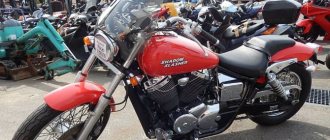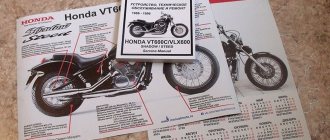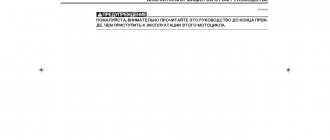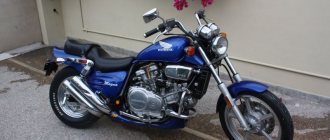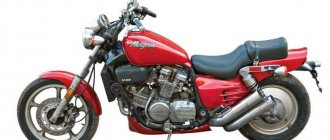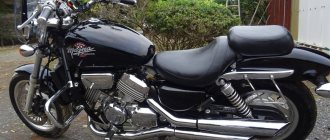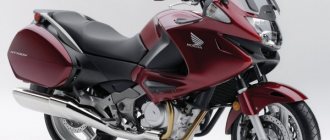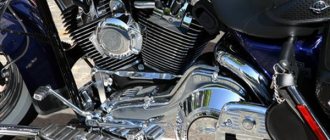Magna 250
- Honda motorcycle model
The Honda Magna 250 cruiser model was first presented at the 30th Tokyo Motor Show in 1993, and official sales began in 1994. The model was aimed primarily at the domestic Japanese market, but was also supplied to Australia. In the Japanese market, the Magna 250 model gained enormous popularity and even took 1st place in sales of motorcycles with an engine capacity of 250 cm³.
The motorcycle is also known by the following names:
Honda V-Twin Magna - this is what Honda called this model in the Japanese market. Honda Magna 250 - the model was not officially called that, but at Japanese auctions it is sold under this name. Honda VT250C V-Twin Custom is a name for foreign markets, particularly the Australian market. The model was based on a 2-cylinder V-shaped liquid-cooled engine from the Honda VT250 Spada, which was slightly retuned and received different carburetors. This significantly reduced the maximum power (to 27 hp), but increased the torque characteristic, making it fully available at 7500 rpm (at 9000 rpm for the Spada).
In 1996, a new addition to the Magna 250 line appeared - the Honda Magna 250S. The official name of the model is Honda V-Twin Magna S. The modification is distinguished by an almost monolithic front wheel, rear shock absorbers with chrome linings and the presence of an alarm button. This model was produced in 1996 and 1997, after which it was discontinued and no longer offered.
2006 was the last year of production of the Magna 250, after which it was removed from the Honda motorcycle line. Removal from the production line was due to the release in 2007 of updated environmental standards, which the motorcycle engine did not comply with. Currently, the model is present in large quantities at Japanese auctions and is in definite demand in Russia as a first motorcycle for novice drivers and girls.
The “big brother” of the model is the Honda Magna 750 (V45).
For whom
Here are the main features of the Honda Magna 250:
- huge popularity in Japan;
- small maximum power of 27 hp;
- ease of operation;
- relatively low cost.
If a fragile girl wants to ride a cruiser, then this option will be one of the best. The bike is not very productive, which is why it is relatively safe, so the Honda Magna 250 is perfect for novice drivers.
Brief history of the model
1994 - launch of the Honda Magna 250 motorcycle. Model: Honda Magna 250 (Japan, Australia). Frame number: MC29-1000001-1029392. Factory designation: VT250Cr.
1995 - no significant changes. Model: Honda Magna 250 (Japan, Australia). Frame number: MC29-1000001-1099999. Factory designation: VT250Cr-II.
1996 - appearance of the Honda Magna 250S modification. The official name is Honda V-Twin Magna S. Model: Honda Magna 250S (Japan). Frame number: MC29-1100001-1199999. Factory designation: VT250Cr-III, VT250Cr-IV.
1997 - no significant changes. Last year of release of the S version. Model: Honda Magna 250, Honda Magna 250S (Japan, Australia). Frame number: MC29-1200001-1499999. Factory designation: VT250Cv, VT250Cv-II, VT250Cv-V, VT250Cv-VI.
1999 - the model receives a new exhaust that meets new environmental and noise standards, and a thinner seat. The footpegs are moved 40 mm forward. Model: Honda Magna 250 (Japan, Australia). Frame number: MC29-1500001-1509999. Factory designation: VT250Cx, VT250Cx-II.
2001 - no significant changes. Model: Honda Magna 250 (Japan, Australia). Frame number: MC29-1510001-1519999. Factory designation: VT250C1.
2003 - no significant changes. Model: Honda Magna 250 (Japan, Australia). Frame number: MC29-1510001-1519999. Factory designation: VT250C3.
November 2004 - the model receives the “Spirit of Phoenix” logo on the tank, a reinforced steering wheel locking mechanism (to protect against theft), protection against turning on the ignition directly and wiring for connecting the immobilizer and security alarm. Motorcycles of this generation are similar to the 2005 models. Model: Honda Magna 250 (Japan, Australia). Frame number: MC29-1600001~. Factory designation: VT250C5.
November 2006 - The model receives a new black paint job (including the engine) and a redesigned logo on the fuel tank. Last year of production. Quite a few models of this generation were produced, since updated environmental standards came out in 2007 and the motorcycle was removed from the line after just a few months of production. Model: Honda Magna 250 (Japan, Australia). Frame number: MC29-1700001~. Factory designation: VT250C6.
Engine
A four-stroke two-cylinder version is used as the driving unit. It has a V-shape. At 7500 rpm it produces 22 Nm of peak torque. At 10,000 rpm the maximum power is 27 hp. The maximum speed of the model is 140 km/h.
The carburetor system will please those who do not accept the injection system. The engine is cooled using liquid. The Magna 250 has four valves per cylinder. The effective volume of the unit is 245 cm³.
Video
Honda Magna 250
— an entry-level cruiser designed to familiarize yourself with motorcycles of this class, in other words, for beginners. Inexpensive, not too powerful and easy to control, it is perfectly suited for learning to ride a motorcycle, especially if the newly minted biker plans to ride more powerful cruisers in the future. Of course, a 250 cc engine will not seem enough for many motorcyclists, but for a first-season beginner, or, say, for a short, fragile girl, the Magna 250 is just right, no worse than its brother Honda Rebel 250. In addition, the Magna is superior to “ Rebel" in all respects.
This light and nimble cruiser was produced without any changes from 1994 to 2003. It was equipped with a liquid-cooled V-twin engine, capable of producing very impressive performance for a modest volume - 27 horsepower and 23 nm of torque. True, the character of the Honda Magna 250 engine is not entirely chopper - it loves high speeds, and its power peaks at around 10,000 rpm. Otherwise, this is a typical lightweight chopper - a steel tubular frame, chain drive, drum brake on the rear wheel and a carburetor power system. However, Honda doesn’t make bad motorcycles, and the younger Magna (and there is also an older one - the Honda V45 Magna 750) was no exception to this pleasant rule.
Externally, the motorcycle follows the style canons characteristic of its class - long and low, it is the embodiment of a classic. Long & low, as American bikers say about such motorcycles - long and low. The squat, elongated silhouette of the Honda Magna 250 does not look heavy and massive, like some kind of Harley-Davidson; on the contrary, it seems swift and quite aggressive. An inexperienced motorcyclist is unlikely to immediately recognize that the “heart” of this bike is just a 250 cc engine.
However, thanks to its modest weight (the dry weight of the Honda Magna 250 is 171 kg), the motorcycle seems surprisingly dynamic, and the short first two gears contribute to brisk acceleration. The bike is capable of reaching the first hundred kilometers per hour in less than seven seconds, and its maximum speed is 140 kilometers per hour. Not a bad indicator for a small-capacity engine, which, by the way, was later also installed on the Honda VTR 250. There are also enough brakes - the brake disc on the front wheel comes in handy here, so you can forgive the rather awkward operation of the rear drum brake. And in general, the Magna 250 is very, very pleasant to handle, and the low seat height (71 cm) makes this motorcycle comfortable for people of short stature. The gas tank holds 11 liters of fuel, which, taking into account the average consumption of 3.5 liters, gives the Magna a good power reserve.
Of course, this model, inexpensive and simple, is not intended for experienced motorcyclists, but for beginners who are just beginning their acquaintance with the fascinating world of motorcycling. And it should be noted that the bike copes with its role with a solid five. Its design simplicity, light weight, easy-going friendly character, attractive appearance and affordable price make it popular among novice bikers. You can even say that the Honda Magna 250 is one of the best choppers for beginners. At a minimum, he will not be inferior to the vast majority of his classmates and competitors.
Dimensions and weight
The bike has an average length for a cruiser of 2315 mm. It is 1065 mm high and 880 mm wide. The seat height is very small - only 690 mm. The wheelbase dimensions are 1620 mm. The empty weight of the bike is 171 kg, while the motorcycle weighs 183 kg including fuel. The tank volume is 11 liters, which is quite enough with an average consumption of 3 liters per 100 km of road.
Review of the Honda Magna 250 motorcycle
The motorcycle is good for the city, quite versatile, but not very suitable for long-distance travel. Pilots of average height will feel comfortable on it. For beginners and girls it is perfect as a first motorcycle - light, easy to maintain, reliable, maneuverable and handles well, beautiful and original. As it turned out later, in terms of dimensions this is not a “minichopper” at all - the length, seat height and ground clearance are standard for motorcycles of this type. Well, according to the manufacturer’s plan, this is not a chopper at all - its full name is Honda Magna 250 Custom Cruiser 
It’s unusual and you can’t argue with that - a powerful cast rear disc, hooliganly raised exhaust pipes, a fork slightly moved forward, a tidy on the tank like an adult chopper and a little chrome so that it sparkles nicely in the sun. The look is not at all classic, but memorable and eye-catching.
Wow, it even has liquid cooling! Of the two of us, only I was fuming in traffic jams; Magna didn’t care. The engine, by the way, is not a v-twin at all - the angle is different, I don’t know what it’s cleverly called. The engine has no low end, you have to constantly apply the gas, but at medium speeds it is pleasantly eager to fight and drives quite briskly; from a traffic light it is quite possible to race with boxes, Chinese and scooters =) It feels like the Steed four hundred is kind of wooden compared to the Magna. melancholy. Magna is clearly more fun.
The device accelerates to 140 km/h, but driving at such a speed is uncomfortable, you feel like you are driving at the limit, there are no special vibrations from the engine, but it begins to sway unpleasantly in the wind. But driving at 110-120 is quite comfortable - there is a small margin for overtaking and the engine does not squeal so angrily.
The gearbox is 5-speed, the shifts are clear, but as with all simple gearboxes, there is some annoying difficulty in finding neutral.
The brakes at the rear are drum, which is probably bad, but everything is learned by comparison, and I’ll tell you - these brakes stop Magna’s weight just fine (compared to other chopper-type ones). Especially if you learn to brake correctly - first the rear, then the front, and do not peck forward behind the motorcycle, but lean back as much as possible. When I learned to brake, the braking distance was reduced by three times.
Magna's suspension is soft, the back doesn't crumble into underpants on bumps, the fork swallows any holes and bumps, you drive over speed bumps easily and naturally. This is pleasant until you brake with the front brake - when braking, the muzzle bites strongly. This could probably be fixed by adding thicker oil to the fork, but I haven't tried it.
The main advantage of this chopper is its controllability. It steers like a bicycle at any speed, the main thing is to look where you want to steer, and not at the red Audi A5 parked at the side of the road. At low speeds, the motorcycle is very easy to control; I have never been able to fall over when turning. It is understandable and predictable. Driving through traffic jams is no problem, it’s nimble and will slip through any crack.
It steers like a bicycle at any speed, the main thing is to look where you want to steer, and not at the red Audi A5 parked at the side of the road. At low speeds, the motorcycle is very easy to control; I have never been able to fall over when turning. It is understandable and predictable. Driving through traffic jams is no problem, it’s nimble and will slip through any crack.
In general, I enjoy its handling! But he really doesn’t like markings. Especially those reverse markings on Volgogradka, and especially in the rain. And also the cut asphalt, sometimes there was a feeling that the front and rear wheels each lived their own separate lives. But probably all light motorcycles don’t like longitudinal irregularities.
The seating position is straight and classic, the seat is wide, you don’t have to reach for the steering wheel. In my opinion, the fit is comfortable, natural, legs and arms are relaxed, everything is where it should be. I didn’t get tired during long rides, although the seat could have been made softer. By the way, if we measure ourselves, I’m 182 cm... I mean height, what did you think? So, with my height, I can still sit normally, but taller people will feel uncomfortable on this Magna. In general, this is an ideal motorcycle for short people, and this is understandable - the Japanese produce it for the domestic market.
Passenger seat. If you are taller than the average Japanese, forget about the passenger! Just forget it. Be selfish, ride alone and have fun! Of course, if absolutely necessary, you can always place a second number and get from point A to point B, but there will be no thrill on this trip.
Awesome motorcycle!!! Well, if you want to ride more than 140, then you need to take 750. And 120 it goes very well! Well, yes... It doesn’t accelerate very quickly, but you can still make cars at traffic lights! I buy consumables at Accelerator, they have EVERYTHING for it!!! To order. In the second year, it also seemed to me that there was not enough power, I started driving more aggressively, and again it seemed fine!!! I drive calmly and predictably. I'm having fun!!! I don’t want to change yet! And no one can compare with her in beauty!
Chassis and brakes
The tubular steel frame looks great thanks to well-chosen colors and tones. The exterior is not pretentious, but bright. The wheels are cast, slightly curved. The steering wheel has standard dimensions for a cruiser.
